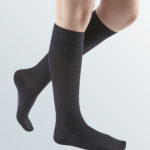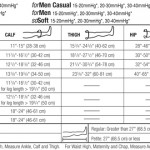Liberty Oxygen
Updated 3:40 PM CDT, Fri October 27, 2017
 Image for Compression Therapy 101
Image for Compression Therapy 101
 Compression is a commonly used type of therapy which provides relief to those who suffer from various circulation issues, including chronic venous disorders, such as thrombosis and edema. Designed to apply gradient pressure, compression stockings are a specialized hosiery that will help increase circulation and prevent blood clots. Compression stockings fit tightest at the ankles and the compression gradually reduces towards the knees and thighs. This design forces better circulation in the narrow veins which results in less swelling, more blood returning to the heart and less blood pooling in the feet.
Benefits of wearing compression garments may include:
Compression is a commonly used type of therapy which provides relief to those who suffer from various circulation issues, including chronic venous disorders, such as thrombosis and edema. Designed to apply gradient pressure, compression stockings are a specialized hosiery that will help increase circulation and prevent blood clots. Compression stockings fit tightest at the ankles and the compression gradually reduces towards the knees and thighs. This design forces better circulation in the narrow veins which results in less swelling, more blood returning to the heart and less blood pooling in the feet.
Benefits of wearing compression garments may include:
- Improve venous blood circulation
- Decrease the risk of blood clots
- Decrease swelling
- Prevent venous blood from pooling in the legs
 Proper fit is crucial to ensure successful compression therapy. There are several levels of compression available providing gradient levels of compression throughout the sock, so it is best to be measured by a professional or your doctor. The compression types are as follows:
8 – 15 mmHg: very mild level of compression
15 – 20 mmHg: moderate level
20 – 30 mmHg: popular for those who travel or on their feet much of the day
30 – 40 mmHg: offers high level of compression and is commonly used after surgery
In addition to compression stockings, TEDs (anti-embolism stockings) are an option. TEDs are typically used with bed bound (non-ambulatory) patients. Where compression hosiery offers a gradient compression throughout the leg, TEDs garments administer pressure on the lower legs and feet with most of the compression at the calf. TEDs garments are designed to prevent blood clots from developing in those who are not up moving around on their own. To help keep the two types straight, remember ‘TEDs are for bed’.
Liberty Oxygen and Medical Equipment carries a variety of brands and styles to fit your needs and has certified fitters at all eight Twin Cities locations. Our fitters will assist you in selecting your stockings, donning, proper compression, style, fabric and color. Our certified fitters are knowledgeable in compression therapy, the equipment commonly used, and will provide tips and demonstration to help put the garments on.
Proper fit is crucial to ensure successful compression therapy. There are several levels of compression available providing gradient levels of compression throughout the sock, so it is best to be measured by a professional or your doctor. The compression types are as follows:
8 – 15 mmHg: very mild level of compression
15 – 20 mmHg: moderate level
20 – 30 mmHg: popular for those who travel or on their feet much of the day
30 – 40 mmHg: offers high level of compression and is commonly used after surgery
In addition to compression stockings, TEDs (anti-embolism stockings) are an option. TEDs are typically used with bed bound (non-ambulatory) patients. Where compression hosiery offers a gradient compression throughout the leg, TEDs garments administer pressure on the lower legs and feet with most of the compression at the calf. TEDs garments are designed to prevent blood clots from developing in those who are not up moving around on their own. To help keep the two types straight, remember ‘TEDs are for bed’.
Liberty Oxygen and Medical Equipment carries a variety of brands and styles to fit your needs and has certified fitters at all eight Twin Cities locations. Our fitters will assist you in selecting your stockings, donning, proper compression, style, fabric and color. Our certified fitters are knowledgeable in compression therapy, the equipment commonly used, and will provide tips and demonstration to help put the garments on.
 Due to the actual compression and the thick material the stockings are made of, it can be difficult to put them on. This difficulty is one of the most common reasons for failed compression therapy. There are several ways to successfully put on compression stockings, including:
Due to the actual compression and the thick material the stockings are made of, it can be difficult to put them on. This difficulty is one of the most common reasons for failed compression therapy. There are several ways to successfully put on compression stockings, including:
- Turn the sock inside out and, starting at the toes, inch the sock up the leg
- Use rubber gloves to obtain a better grip on the stocking and helps to avoid snags
- Use a rigid sock aid
- Use a stocking donner

Comments